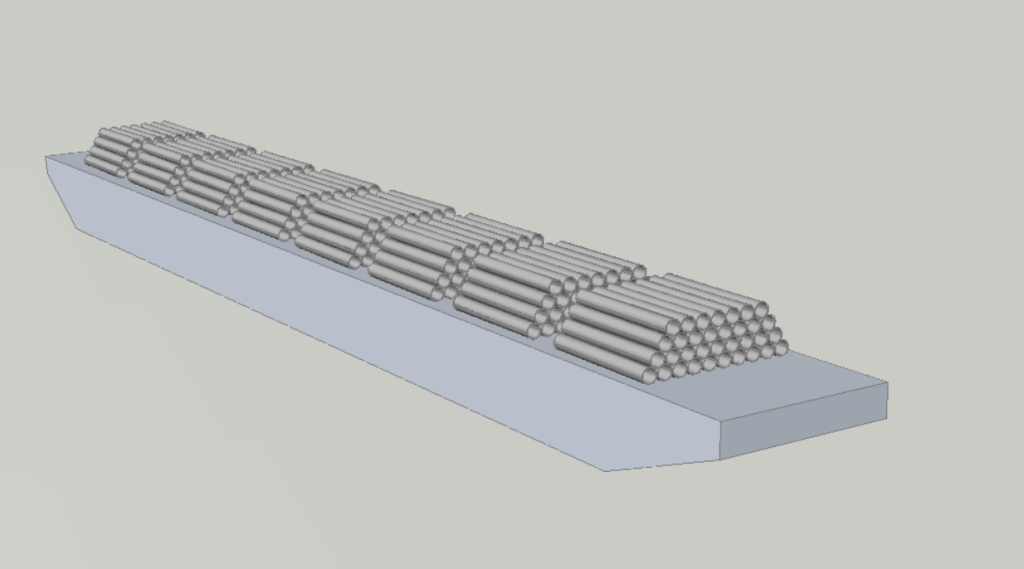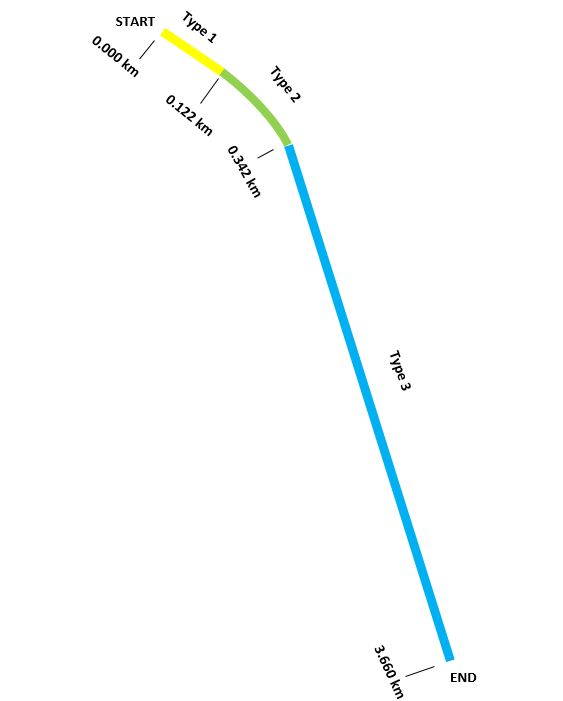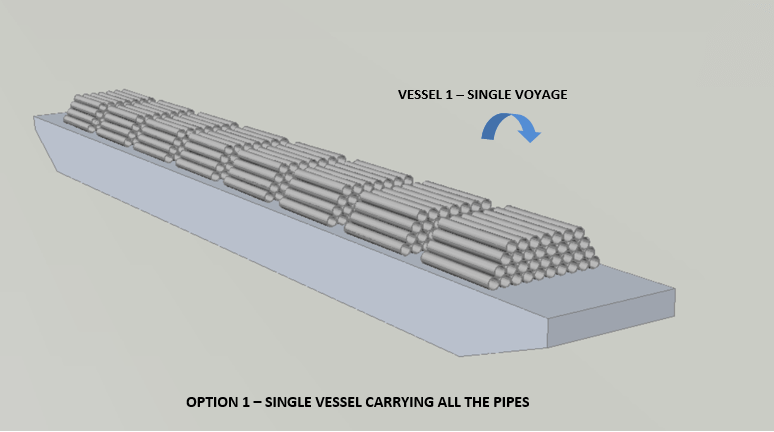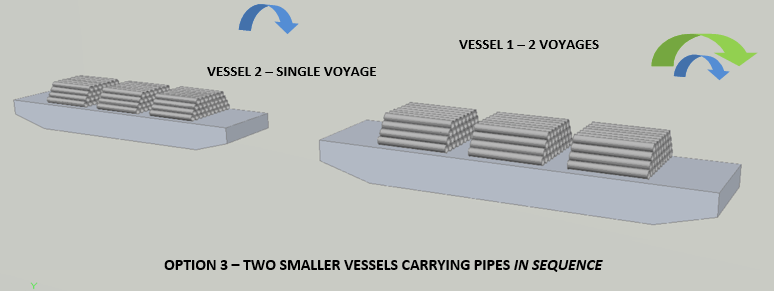
In Part 1, we looked at the properties of pipes. In this section, we will be looking at the Planning & Scheduling of a pipe transportation operation (see below, Phase 1 & 2)
SECTION 2: PLANNING, SCHEDULING, AND ENGINEERING FOR A PIPE TRANSPORT PROJECT

Source: pixabay.com
Now that we know about pipes and how to calculate their stacking limit, what next? We need to find out how to transport them. The whole process of Pipe Transportation and its Engineering can be divided into the following Phases
- Phase 1 – Establish the scope of transportation. This includes the total pipes to be transported, their properties and their weights. This would also entail the route of transportation.
- Phase 2 – Vessel selection and schedule preparation
- Phase 3 – Engineering. This includes engineering analyses and calculations for the pipe types and the vessels selected.
- For the pipes, we need to carry out stacking height calculations, and prepare detailed lifting plans for each pipe type (to lift them from Quay side to the vessel)
- For the vessels, engineering includes detailed plans and analyses demonstrating the suitability of the vessel for pipe transport. This document is called a ‘Transportation Analysis’, and includes
- Vessel stability and strength check
- Motions analysis as per the environment
- Preparation of stowage plans
- Seafastening design for the pipes
- Preparation of lashing plan
- Bollard Pull calculations, if the vessel is a towed barge
- Towing/Emergency Towing Arrangement as applicable
- Phase 4 – Execution of the actual transportation operation. This includes
- Lifting of pipes from quayside to the vessel
- Loading of pipes on the vessel as per the stowage plan and schedule
- Transporting pipes to final location of discharge
- Unloading of pipes at the final location
Phase 1 – Establish the scope of work.
Usually, the requirement of a project comes with a list of pipes to be transported. This list will contain the different pipes and their quantity to be used for a stretch of a subsea pipeline. Let’s consider a hypothetical stretch of a subsea pipeline shown below.

Each color depicts a different pipe type to be utilized for that stretch. The first pipe type (in Yellow color) is Type 1, and stretches for the first 0.122 km. The second is Type 2 pipe which stretches for the next 0.2196 kms, and the third is Type 3 pipe which spans the longest segment of 3.318 kms. If we list it in a tabulated form, the Table looks like below:

The table provides the details of all pipe types to be utilized in laying this section of the Pipeline. It gives their diameter, wall thickness, corrosion coating, concrete coating, weight, and Quantity.
We can see that the last column of the above table is “Lay Rate”. The Lay rate is nothing but the planned rate at which the pipe has to be laid on the sea bed. In above table, the Type 1 pipe has a lay rate of 70, i.e., 70 Nos. of Type 1 pipes must be laid on the sea bed per day. This implies that at least 70 pipes must be transported and supplied per day to the pipe-laying vessel. The lay rate assumes great significance in preparation of the schedule of the pipe transportation.
This phase also provides the details of the location where the pipes are to be loaded from and the location where they are to be supplied to. Usually, pipes are loaded from a Yard/Quayside to the transport vessel, and they are delivered to a pipe laying vessel at the other end.
Phase 2 – Selection of vessels and preparation of schedule.

Source: pixabay.com
In this phase, the pipe transportation contractor will select appropriate vessels suitable for the transportation and present a detailed plan to the client showing the sequence in which the vessel(s) will be deployed for transportation. This is not a linear process, and the vessel selection and schedule affect each other. Multiple vessels may be deployed to ensure that the lay rate is maintained. At times, a bigger transport vessel may be selected to transport the pipes to a location close to the pipelay vessel, and smaller barges deployed to trans-ship the pipes from the transport vessel to the pipelay vessel. This kind of operation is called Trans-shipment. The number of vessels selected also affects the costs of the entire operation, and it is important to strike the right balance between the number & types of vessels selected and meeting the lay rate.
Let’s take a very simple example with this hypothetical scenario:
We need to transport 1200 pipes to a pipelay vessel from a yard. The journey time from yard to pipelay vessel is 1 day. The loading rate of pipes is 200 per day. The lay rate is 100 pipes per day. We need to select vessels and plan a schedule for the transportation.
For selecting the vessels and preparing the schedule, we can have various options. We will explore three options below. The selection of the best option depends on the feasibility and costs.
Option 1 – Select a vessel big enough to transport all 1200 pipes in one go.

The entire schedule can be as follows:
- Days 1 through 6 – Vessel loads 200 pipes per day
- Day 7 – Vessel departs.
- Day 8 – Vessel reaches the lay barge and unloads 100 pipes to the lay barge.
- Days 9 to 19 – Vessel discharge 100 pipes per day to lay barge
- Day 20 – Vessel departs and finishes its contract.
Thus, total number of days of contract of Vessel = 20 days
Project duration = 20 days
If the contract rate of the vessel is USD 10000 per day (assumption), then total cost of contracting = USD 200000
Option 2 – Select two smaller vessels (say barges) of capacity 600 pipes each and make them work in parallel. Both barges depart together and arrive at the same time to the lay barge. However, the lay barge may have a limitation to allow only one barge at a time. So, while the first barge is unloading to the lay barge (5 days), the second barge is idle, waiting for its turn.

The entire sequence can be
- Days 1,2 & 3 – Vessels 1 & 2 loads 200 pipes each per day
- Day 4 – Both vessels depart.
- Day 5 – Both vessels arrive. Vessel 1 discharges 100 pipes to lay barge. Vessel 2 is idle
- Day 6 –Vessel 1 discharges 100 pipes to lay barge. Vessel 2 is idle
- Day 7 –Vessel 1 discharges 100 pipes to lay barge. Vessel 2 is idle
- Day 8 –Vessel 1 discharges 100 pipes to lay barge. Vessel 2 is idle
- Day 9 –Vessel 1 discharges 100 pipes to lay barge. Vessel 2 is idle
- Day 10 –Vessel 1 discharges 100 pipes to lay barge. Vessel 2 is idle
- Day 11 –Vessel 1 departs. Vessel 2 discharges 100 pipes to the lay barge
- Day 12 –Vessel 2 discharges 100 pipes to lay barge. Vessel 1 reaches yard and finishes contract.
- Day 13 –Vessel 2 discharges 100 pipes to lay barge
- Day 14 –Vessel 2 discharges 100 pipes to lay barge
- Day 15 –Vessel 2 discharges 100 pipes to lay barge
- Day 16 –Vessel 2 discharges 100 pipes to lay barge
- Day 17 – Vessel 2 departs and finishes its contract.
Total duration of contract of Vessel 1 = 11 days
Total duration of contract of Vessel 2 = 17 days.
Total project duration = 17 days.
If the contracting cost per vessel is USD 7000 per day, then total contracting cost = (17 + 11) x 7000 = USD 196000
Option 3 – Select two smaller barges and make them work in sequence. Let’s say the capacity of each vessel is 400 pipes.

The entire schedule with these two vessels can be
- Days 1 & 2 – Vessel 1 loads pipes (200 per day)
- Day 3 – Vessel 1 departs.
- Day 4 – Vessel 1 reaches the lay barge and unloads 100 pipes.
- Day 5 – Vessel 1 discharges 100 pipes to lay barge. Vessel 2 starts loading pipes at yard.
- Day 6 – Vessel 1 discharges 100 pipes to lay barge. Vessel 2 finishes loading pipes at yard.
- Day 7 – Vessel 1 discharges 100 pipes. Vessel 2 leaves yard.
- Day 8 – Vessel 2 arrives and discharges 100 pipes to lay barge. Vessel 1 departs.
- Day 9 – Vessel 2 discharges 100 pipes to the lay barge. Vessel 1 reaches yard and starts loading
- Day 10 – Vessel 2 discharges 100 pipes to the lay barge. Vessel 1 finishes loading
- Day 11 – Vessel 2 discharges 100 pipes to the lay barge. Vessel 1 leaves yard
- Day 12 – Vessel 1 arrives and discharges 100 pipes to the lay barge. Vessel 2 departs.
- Day 13 – Vessel 1 discharges 100 pipes to the lay barge. Vessel 2 arrives at yard and finishes its contract.
- Day 14 – Vessel 1 discharges 100 pipes to the lay barge.
- Day 15 – Vessel 1 discharges 100 pipes to the lay barge.
- Day 16 – Vessel 1 departs and finishes its contract.
Total duration of contract of Vessel 1 = 16 days
Total duration of contract of Vessel 2 = 9 days.
Total project duration = 16 days.
If the contracting cost of each vessel is USD 5000 per day, then total contracting cost = (16 + 9) x 5000 = USD 125000.
A table summarizing the time and cost outcomes of all three options is presented below:

Thus, we can see that from the point of view of both cost and time effectiveness, the Option 3 is the best option. Thus, bigger is not always better in pipe transportation.
*****A note of Caution!
The above example was a highly simplified one, and in real cases, the scheduling and selection of vessels is a complicated exercise. There are other factors and costs involved which should be accounted for, and the voyage times of different vessels may be different. It is not the intention of this article to get too deep into this subject. Let’s move on to Phase 3 – engineering.
Disclaimer: This post is not meant to be an authoritative writing on the topic presented. thenavalarch bears no responsibility for any incidents or losses arising due to the use of the information in this article in any operation. It is recommended to seek professional advice before executing any operation which draws on information mentioned in this post. All the figures, drawings and pictures are property of thenavalarch except where indicated, and may not be copied or distributed without permission.
Please register or login to read the full article
Thanks for the write-up.
please, can you provide us with a detail part of the planning and scheduling especially phase 4?
Thanks
Hi Saheed
Thanks for your feedback. Can you please write to us with a bit more detail on the information you’re looking for? info@thenavalarch.com
Hi can we get details of phase 4 i.e. execution part.
Hi Jitesh
Thanks for your inquiry. Phase 4 requires in-depth operations experience that we don’t have in-house currently. Should this change in the future, we’ll definitely add related content.
Thanks for your visit
Team TheNavalArch